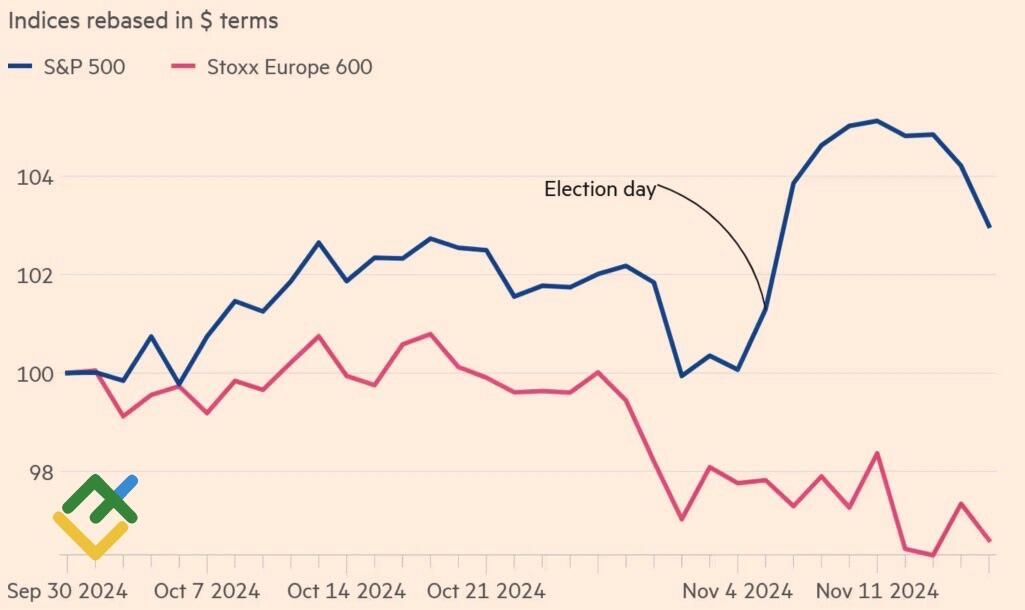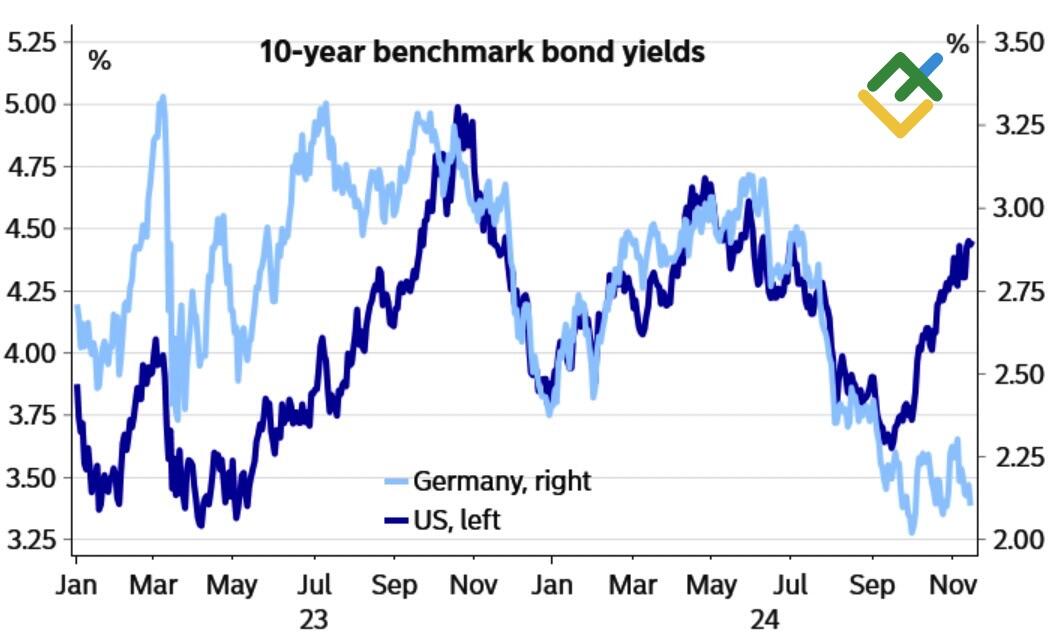
The Fed and the ECB’s differing pace of interest rate cuts is not the sole reason for the EURUSD pair’s collapse. The significant gap in stock index gains and the rally in US Treasury yields have attracted capital flows to the US. Let’s discuss this topic and make a trading plan.
The article covers the following subjects:
Major Takeaways
- The gap between US and European stock indices is widening.
- The bond yield differential favors the US dollar.
- Markets are revising their outlook on the Fed’s plans.
- The EURUSD pair continues to slide towards 1.035.
Weekly US Dollar Fundamental Forecast
Donald Trump’s victory has prompted a renewed focus on American exceptionalism in the financial markets. The growth rate of US-issued stocks is significantly higher than that of their European counterparts. The increase in Treasury yields is occurring at a faster rate than that of German bonds. Consequently, capital flows from Europe to the US are gaining momentum, pushing the EURUSD pair toward parity.
In light of the impending fiscal stimulus from the Republican party, the S&P 500 index has seen a 23% surge year-to-date. The Euro Stoxx 600 has only added 5%. European equity markets are concerned about the potential impact of import tariffs and trade wars. The discrepancy between European and US stocks has never been so wide. Some market analysts have dubbed this the “Trump gap.”
US and EU Stock Indices’ Performance
Source: Bloomberg.
During his previous presidential term, Trump viewed the stock market as a performance indicator. Investors are counting on Donald Trump to maintain the upward trajectory of the S&P 500. However, his actions could potentially disrupt this positive trend.
It is widely assumed that the increase in US Treasury yields is driven by expectations of fiscal stimulus, which will lead to an expansion of the budget deficit and government debt and an increase in issuance. Meanwhile, bond yields are rising partly due to the high probability of a robust US economy under Donald Trump. It is already in a stable position. For instance, retail sales increased by 0.4% in October, exceeding expectations. The September growth rate was revised from +0.4% to +0.8% on a monthly basis.
The situation in Europe is markedly different. A month ago, Bloomberg experts anticipated that the German economy would avoid a recession, which would mark two consecutive years of GDP contraction. In November, they revised their forecast for 2024 to -0.1%. Following a 0.3% decline in gross domestic product in 2023, this indicates that a recession is likely. Notably, German bond yields are not rising, and the widening yield differential is contributing to the EURUSD bear market.
US and Germany’s benchmark bond yields
Source: Nordea Markets.
The US dollar has demonstrated consistent growth for seven consecutive weeks, marking the longest winning streak since February. At that time, the greenback benefited from a reduction in expectations for the extent of the Fed’s monetary expansion due to the unexpected acceleration of inflation. A similar trend is currently unfolding. The futures market predicts three federal funds rate cuts in 2025 at 25 bps each, twice as low as at the end of September.
Weekly EURUSD Trading Plan
The American exceptionalism, the capital spillover from Europe to the US, and the slowdown in the Fed’s monetary policy easing cycle are pushing EURUSD quotes downward. Only a correction in the S&P 500 index can support EURUSD bulls, but it is unlikely to be long-lasting. Short trades with the target of 1.035 remain relevant.
Price chart of EURUSD in real time mode
The content of this article reflects the author’s opinion and does not necessarily reflect the official position of LiteFinance. The material published on this page is provided for informational purposes only and should not be considered as the provision of investment advice for the purposes of Directive 2004/39/EC.
{{value}} ( {{count}} {{title}} )
This post is originally published on LITEFINANCE.






